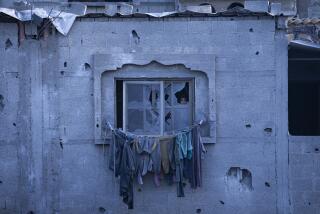Cairo Disaster’s Horrors Continue
- Share via
CAIRO — The doctor heard the pinned man begging Monday: “Give me oxygen! Get me out of here!” But rescuers could not reach him deep under the rubble, and, after three agonizing hours, the victim succumbed--another casualty in a building collapse that left at least 15 people dead and up to 80 missing, with little hope for their survival.
In an instant, a 12-story concrete apartment house in the Heliopolis district--an affluent suburban area near where Egyptian President Hosni Mubarak has his palace--was reduced to a five-story mound of dust and twisted steel rods. The pile was strewn with carpets, cushions, bits of broken furniture and clothing from the building’s occupants.
Firefighters with shovels clambered over the debris, listening for survivors and looking for corpses, as listless friends and relatives sobbed or sat bleary-eyed on the pavement, imagining the fate of their loved ones buried nearby.
“For nine hours, I have been hearing the voices of my sister and her friend, calling from under the ground,” said a weeping Shireen Mekky of her sister Sally, who was working as a trainee at a travel agency in the building.
For Egyptians, the disaster seemed certain to rekindle controversies dating from a 1992 earthquake whose deadly toll focused attention on seemingly endemic problems with substandard construction and poorly enforced building codes in this apartment-starved city of 15 million people.
Strict rent-control laws--a holdover from the 1960s Socialist era of former President Gamal Abdel Nasser--have left property owners at least one path to quick, easy riches: They add new apartments, pell-mell, atop existing structures and then sell the new units.
The prevalence of this practice is visible just by a glance at the skyline, especially in choice neighborhoods like Heliopolis, with its tony shopping district, restaurants that cater to the country’s nouveaux riches and upscale apartments convenient to both the city center and the airport.
In the aftermath of the ’92 quake, which killed at least 550 people, newspapers were filled with reports of corrupted construction standards, of contractors building badly or using poor materials and of property owners flouting codes via bribes or connections.
There were calls for reform then, as there are certain to be now. Within hours of this latest tragedy, authorities announced the arrest of the collapsed building’s owner along with two engineers he employed, saying they illegally added five stories in the 1970s and defied city orders to demolish them.
The incident occurred just after 6:30 p.m. Sunday. Witnesses said floors toppled into each other, creating a huge swirl of dust. When it cleared, the building, which had been sandwiched between two other similar-sized apartment houses, was simply gone.
Sani Mohammed Abdel, a security guard next door, said he was just about to wake up a napping co-worker when “I felt the dust coming into the room and saw there was a car on fire outside in front of the building. I thought maybe the electrical room had exploded or there had been an earthquake.”
The sound he heard was “like a cannon explosion,” he said. Then there was silence. “There was nobody coming from the building, no screams, nothing,” he said.
Officials said emergency crews and ambulances reached the scene in 15 minutes. Dr. Mohammed Talat Ezzedin, one physician summoned, recounted a grisly, heart-wrenching night of searching for survivors by listening for them calling from under the rubble. One woman found this way was rescued almost unscathed; her 20-year-old son, though, was dead atop her.
About 6 a.m., Ezzedin said, rescuers extricated one man and could see beyond him three other people, hanging upside down, their legs pinned by debris. The rescuers got a woman out by amputating her leg. A male survivor was freed--but only after both of his legs had been amputated.
The third victim was buried beneath so much rubble that he could not be freed. “He kept calling to us: ‘Give me oxygen! Get me out of here!’ ” Ezzedin recalled sadly. About 9 a.m., the man died.
Khaled Ali Mahmoud--who spent the night awaiting news of a missing cousin and his family--said of Monday’s horror: “It’s nobody’s fault. It’s destiny.”
But state television reported that the collapsed building had a bad history. Put up in 1969, it had seven stories; five stories were added in 1977 without government approval, resulting a short time thereafter, according to media reports, in a fine for the owner of about $40,000.
In 1993, authorities reportedly ordered the demolition of the building’s illegally built floors. There was no immediate explanation of why that order was never carried out.
Mahmoud Reda Ahmad, an official in the Cairo government’s engineering office, said Monday that renovations being carried out on the building’s first floor also were “haphazard,” with no architectural plans filed for approval, as required by law.
Neighbors said contractors had worked for a week on a space where a bank was to open; some said contractors had removed a weight-bearing column as part of the renovation. An Interior Ministry spokesman on the scene said officials would look into these “rumors.”
More to Read
Sign up for Essential California
The most important California stories and recommendations in your inbox every morning.
You may occasionally receive promotional content from the Los Angeles Times.










